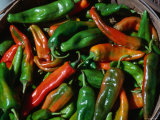Art Custom Framing Gallery Los Cabo San Lucas, San Jose del Cabo, Mexico

 |
|
Chili Peppers
|
Mexico may have 90 varieties of chilies
Chilies
There is more misunderstanding about chilies than any vegetable grown, although they are all members of the genus Capsicum, the same family that produces the mild green bell pepper, sweet red pepper and pimiento.
The confusion is understandable when you consider that, in
One thing you can be sure of is that fresh chilies are an exceptionally rich source of Vitamins A and C. Canned and frozen chilies retain only about two-third of their vitamin content. And in all cases chilies are one of the best known of all natural aids to digestion.
In typical Mexican cooking, the green chilies--which are usually hotter than the red, are used fresh; and the red chilies are used dried. When growing your own one might note that if the pods grow up they are hot, and the mild and sweet peppers grown with their pods down.
THE FRESH GREEN CHILIES
Poblano-This is the chili used for chilies rellenos ( stuffed chilies). It resembles the green bell pepper in shape, which by the way, makes an adequate substitution for it. The poblano is usually mild, with only a faint trace of heat.
jalapeño - This one packs quite a lot of heat in its small pod, which is only about 2 1/2 inches long. While it is called a green chili, it sometimes can be yellow in color.
Serrano - Proceed with caution when you this tiny pod. It's only about 1 to 1 1/2 inches long, abut it's full of fire. Some markets carry a mixture of small fresh green and red chilies simply called hot peppers. These chilies vary from 1 to
DRIED RED CHILIES
Ancho - this one is on the mild side and rather sweet in flavor with only a faint trace of heat. The ancho is sort of flat and roundish about 3 to
Malato - this one has a larger, more tapering pod than the ancho chili and is more brownish than red in color. However, the flavor is much like the ancho, and the two can be interchangeable in recipes.
Pasilla - Hot and pungent, this chocolate brown color chili is thin and about
Chipotle - this chile is not as large as the mulato, but it is extremely hot.
HOW TO PREPARE FRESH CHILIES
A word of warning before you handle any chilies. Once your fingers touch the seeds, where most of the fire is contained, or even the oil in the flesh of the pod, don't rub your eyes without first scrubbing your hands thoroughly with soap and water. Otherwise, you'll get one helluva painful sting.There are several ways the Mexicans peel and de-seed their fresh chilies, but the following method is the quickest and easiest.
First, rinse the chilies in cold water and wipe them dry with paper towels. Lay them close together on a foil-covered cookie sheet or oven rack. Preheat your broiler and place the rack about
As coon as the chilies are cool, peel off the skin with a sharp paring knife. It usually comes off easily in large patches,
To prepare the peeled chilies for stuffing, cut a slit down one side to within about 1/2 inch of the stem. Spoon out the seeds and the veins (ribs). The stem should be left on as a handle for dipping the stuffed chilies into the batter.
If the chilies are going to be cut up for a recipe, simply cut off the stem, any hard core at the top, and remove the seeds by rinsing them out with cold water.
Fresh chilies can be prepared a day ahead and refrigerated in plastic wrap. Or they can be kept frozen for many months.
HOW TO PREPARE DRIED CHILIES
Wash the chilies in cold water and, hold them under the running water pull out the stem, cut or break the chilies in half and remove the seeds and veins. Then tear the chilies into small pieces, place in a bowl and cover with boiling water. Let soak for 40 minutes to an hour before using. The water in which they have soaked can be used as part of the liquid in the recipe.
HOW TO PREPARE CANNED CHILIES
This is very easy. You simple rinse the chilies very thoroughly to rid them of any flavor of the brine in which they were preserved. If you are using the canned green chilies for stuffing, follow the same directions as for the fresh. If you are using them for other purposes, just remove the stems, the veins and the seeds.
In buying canned chilies, be careful not to get the pickled ones (en escabeche) unless specified in a recipe, as the pickling cannot be rinsed away and will really louse up the flavor of a dish.
SUBSTITUTIONS
Fresh green bell peppers, canned poblano or canned
Cayenne pepper can be substituted for chile pequin powder which is made from very hot dried chile. One tablespoon of chili powder may be substituted for one fresh or dried chili. Many Mexican cooks make a chili paste for this substitution by mixing the chili powder with flour and water. The proportions are 1 tablespoon chili powder, 1 teaspoon flour, and 2 tablespoons cold water. When adding this paste to the cooking, it should reach a boil to effect the proper seasoning.
Note; The chili powder we normally buy from our supermarket in the states is actually a blend of several spices and herbs. While this will suffice, you can buy powdered ancho, mulato, or pastilla powder here in the Mexican grocery store if you want the pure chili flavor when called for in a recipe.